Description
Product Description
The Cisco Unified IP Phone 7931G meets the communication needs of retail, commercial, manufacturing workers, and anyone with moderate telephone traffic but also specific call requirements. Dedicated hold, redial, and transfer keys are supplied to facilitate call handling in a retail environment. Illuminated mute and speakerphone keys are provided to give a clear indication of speaker status. A pixel-based display with a white backlight makes calling information easy to see, and Extensible Markup Language (XML) services deliver a rich user experience. The Cisco Unified IP Phone 7931G offers numerous important security features plus the choice of IEEE 802.3af Power over Ethernet (PoE) or local power through an optional power adaptor.
The Cisco Unified IP Phone 7931G is designed to grow with your organization. A dynamic, soft-key driven feature set allows the phone to keep pace with your requirements through regular software upgrades. You can easily move phones, add new phones, and change existing phone arrangements; users can simply pick up their phones and move to a new location anywhere on the network. The Cisco Unified IP Phone 7931G also provides accessibility features for those with special needs. Tables 1 to 7 present the features, specifications, and compliance information for the Cisco Unified IP Phone 7931G, Table 8 provides ordering information, and Table 9 lists available optional accessories.
Features
Lighted line keys -Twenty-four lighted line keys to which can be assigned individual lines-Each line key provides a busy-line indication if the line is shared with another IP phone; lighted line keys are also used to access services and call history directories and to activate the headset port
Dedicated hold, redial, and transfer keys - Dedicated keys for hold, redial, and transfer-The hold key is colored red to make it clearly visible in a fast-moving call environment; the redial and transfer keys are provided to facilitate rapid call handling
Lighted message waiting indicator - Lights turn on when there is new voicemail and when the phone rings; visible on both the phone chassis and handset and stay lit until new voicemail has been processed by the user
Graphical display - Graphical monochrome display with resolution of 192 x 64 pixels and a white backlight provides scrollable three-line intuitive access to calling features and text-based XML applications; the Cisco Unified IP Phone 7931G also supports audio-based XML applications
Four soft keys and a four-way rocker key - Dynamically present calling options to the user; the four-way rocker key allows easy movement through the displayed information
Network features - Cisco Discovery Protocol; IEEE 802.1 p/q tagging and switching
Ethernet switch - 10/100BASE-T Ethernet connection through two RJ-45 ports: one for the LAN connection and the other for connecting a downstream Ethernet device such as a PC
Speakerphone - Full-duplex speakerphone for handling calls hands-free
Volume control - Volume-control toggle to provide easy decibel-level adjustments of the handset, headset, speakerphone, and ringing volume.
Headset port - Dedicated headset port eliminates the need for a separate amplifier when using a headset; allows the handset to remain in its cradle, making headset use simpler
Single-position foot stand - Optimum display viewing and comfortable use of buttons and keys; the foot stand can be removed for wall mounting with mounting holes located on the base of the phone
Multiple ring tones - More than 24 user-selectable ring tones
American Disabilities Act (ADA) features - Hearing-aid-compatible (HAC) handset that meets ADA requirements, including ADA HAC requirements for a magnetic coupling to approved hearing aids; the phone dialing pad also complies with ADA requirements
Signaling protocol support - Compatible with Cisco Unified CallManager Express Version 4.0(2) and later, using the Skinny Client Control Protocol (SCCP)
Codec support - G.711a, G.711u, G.729a, G.729b, and G.729ab audio-compression codecs
Configuration options - Provisioning of network parameters through the Dynamic Host Configuration Protocol (DHCP)
Voice quality - Comfort-noise generation and voice-activity-detection (VAD) programming on a system basis



